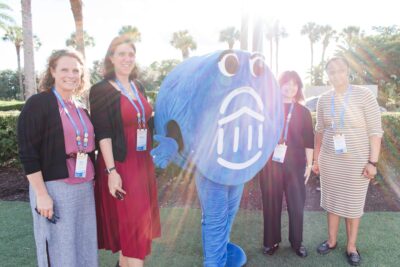What happens to 100 students who enter college?
Caenorhabditis elegans is a microscopic worm found worldwide. What makes C. elegans special are its cells, which always develop in the exact same sequence as the worm grows from embryo to adult. Just by looking at its stem cells, we can know exactly which ones will become stomach, muscle, nerves, and so on. Scientists call this a “fate map”—because it serves as a model to understand how development works in all organisms, including you and me.
As a biologist, I am fascinated by the concept of a “fate map”—an unchanging model of how development occurs across all organisms. I think there’s something beautiful and elegant about knowing precisely what outputs will come from an undifferentiated set of inputs. Unfortunately, what is often true for C. elegans isn’t true for our students. Despite years of data collection, we actually have a very poor understanding of the fate of “embryonic” students when they start their college experience.
Sure, we know that some students will drop out, some will graduate, some will get jobs. But we don’t have a good sense of just how many will experience each outcome. If we don’t truly understand how many students are graduating, how much time (and money) it takes, and what sort of career outcome they can expect, then it becomes difficult to confidently answer the public when they ask, “Is college worth it?”
I wondered if it was possible to stitch together disparate data sets and reports to create a fate map of students who enter college seeking a bachelor degree. Where would each of these students end up? What outcomes would they experience?
Why doesn’t a student fate map already exist?
There are a lot of reasons our current metrics and data reporting fail us. We lack a national student unit record system that longitudinally tracks the educational path of individual students from start to finish. This means that we lose track of students as they move between institutions. From the perspective of an institution (and the graduation metrics they report to the federal government), transfers look like dropouts, artificially depressing the real graduation rate.
Because we measure six-year graduation rates, students who are in college longer than six years also look like dropouts, even if they ultimately complete. Schools are not required to report metrics tracking time (or cost) to degree. As for what happens after graduation, we can’t even agree on a definition for “underemployment,” much less come up with a national system for tracking this outcome for recent graduates.
Assembling an unprecedented view of college outcomes
To construct a fate map of college students, I spent a considerable amount of time during the summer of 2017 analyzing and combining eight different data sources, notably the National Student Clearinghouse and the Federal Reserve Bank of New York, into what I believe to be a holistic view of actual college outcomes. It should be noted that meta-analyses like this one are not created from perfectly aligned datasets, and thus should be treated as “directionally correct” estimates rather than precise measures. Nevertheless, what I found was startling:
For every 100 students who start a bachelor degree…
Twenty-two will fail to earn any credential. Fourteen of these students are first-generation and half are underrepresented minorities. They typically leave school with loans of $5,000 to $8,000 but do not earn much more than a high school graduate who never attended college. Four of these students will default on their debt, doing financial harm they will bear for years. It’s hard to accept, but many of these students are now worse off than if they had never gone to college in the first place.
Twelve are still enrolled six years after they started. One Student Success Collaborative member calculated that students who spend six or more years in college take out an average of $9,000 more in loans. These students are disproportionately adult learners who started college after age 20. Adult learners are less likely to be full-time students or enrolled continuously and thus, on average, take eight calendar years to graduate. They are also the fastest growing demographic in higher education.
Three will end up earning an associate degree. Anecdotal evidence suggests that many of these students earn degrees in a health profession or information technology, programs that are stepping stones to decent jobs. Nevertheless, an associate degree was not what these students started out to do, and the typical associate degree holder makes $13,000 less per year than if they had earned a bachelor degree.
Twenty-eight students will graduate, but will not be working a job that required a bachelor degree by age 27. The NY Federal Reserve designates a profession as requiring a bachelor degree if 50% or more of the people in that profession hold one. Admittedly, some recent grads make the deliberate choice to wait tables for a few years while they explore creative careers and passions. But with the average loan burden topping $30,000, many other recent grads are asking themselves, “If I didn’t need to go to college to get this job, why did I go in the first place?” This has always been a problem, and will continue to get worse as student borrowing continues to rise.
Out of our original 100 students, we are left with just 35 that will graduate and end up working in a job requiring their degrees. These are the students we can confidently say will get a return on education, and for whom the time—and debt—spent in college will certainly prove worth it.
The picture painted by these snapshots is sobering. Higher education has always sold itself as the gateway to the middle class—but can we really continue to make this claim while sporting a 35% success rate? At a certain point, students will not entertain the costly risk of attending college with uncertain outcomes.
But there is another, more hopeful way to look at this. With 65 out of 100 students experiencing some sort of undesirable outcome, there are ample opportunities for us to improve. Indeed, improving any number on this page constitutes an improvement to student success, and means that at least one more student is getting a return on education.
Sources
- Shapiro D, et al., “Completing College: A National View of Student Attainment Rates – Fall 2010 Cohort (Signature Report No. 12),” National Student Clearinghouse Research Center (2016).
- Federal Reserve Bank of New York, “The Labor Market for Recent College Graduates,” https://www.newyorkfed.org/research/college-labor-market/index.html.
- National Center for Educational Statistics, “Digest of Educational Statistics: 2015,” Tables 306.50 and 326.40.
- National Center for Educational Statistics, “Six-Year Attainment, Persistence, Transfer, Retention, and Withdrawal Rates of Students Who Began Postsecondary Education in 2003-04,” (NCES 2011-152) Table 1.1-C.
- Nguyen M, “Degreeless in Debt: What Happens to Borrowers Who Drop Out” American Institutes for Research (2012).
- The University of Texas at San Antonio, https://www.utsa.edu/moneymatters/cost/graduating.html.
- National Center for Educational Statistics, “Digest of Educational Statistics: 2016,” Table 502.30.
- Institute for College Access and Success, “Student Debt and the Class of 2015,” (October 2016).

More Blogs

Three lessons from 1,200 student success leaders on higher ed’s future

5 higher ed thought leaders we are following
